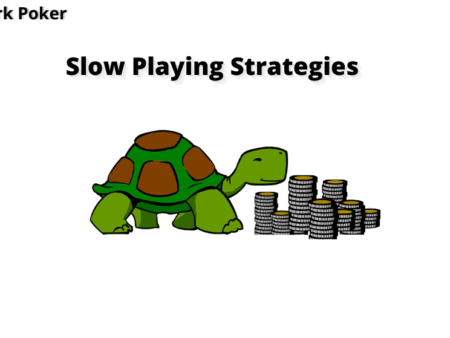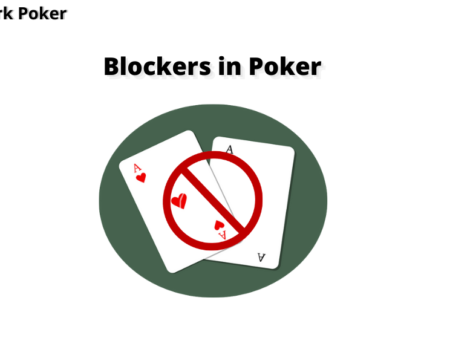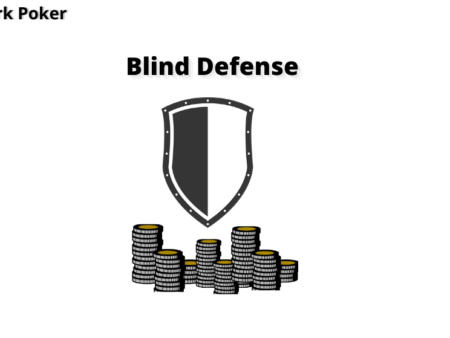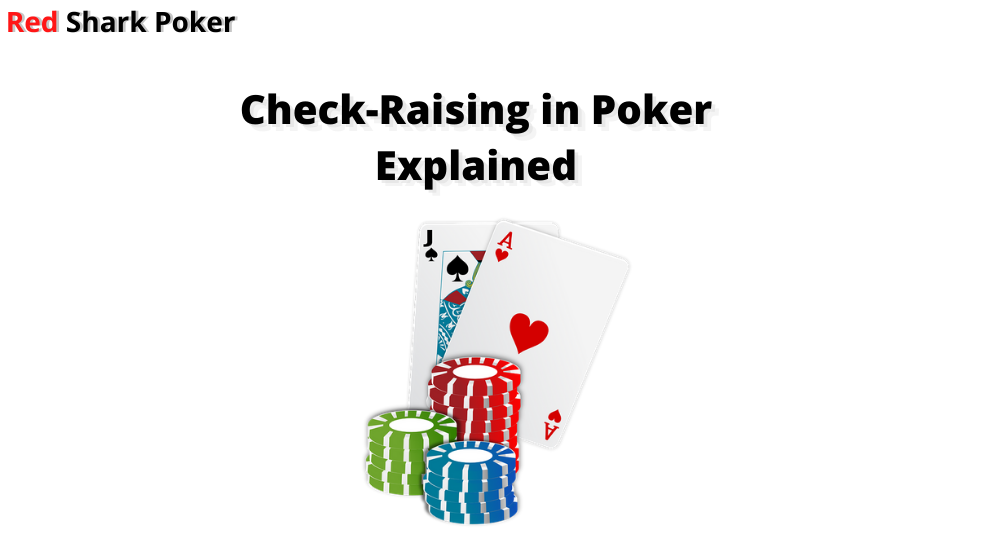
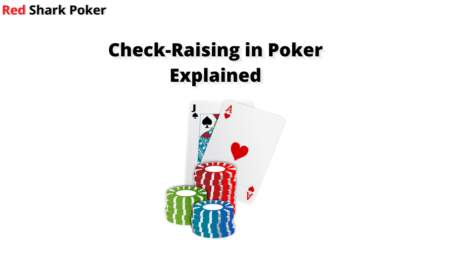
Check raise is a powerful out of position weapon, which can be used for both bluffing and value betting. It is a very tricky move as it changes your perceived range in the same betting round. Checking usually implies that you have a wide range; however, when your opponent bets and you raise instead of calling or folding, your range suddenly becomes strong. This tricky move can confuse your opponent, and you can take down the pot from out of position without holding the best hand.
Let us learn in detail about this deceptive and yet very effective move of check raise in poker.
What is a Check Raise in Poker?
Check-raise is a tricky out of position move where you check when the action gets to you and raise when your opponent bets. So, you are checking first and then raising after your opponent bets. Thus, this play is called “check-raise” in poker. To simply put, this play involves three steps:
- You check first
- Your opponent bets
- You raise
Check raise in poker is a very deceptive move, which can be used for both value betting and bluffing. You allow your opponent to bet first and then extract more money by raising with the best hand. You can also bluff and confuse your opponent with this move to win pots.
An Example of Check Raise in Poker
You are in the big blind and hold J♠ 10♠ in a $5/$10 6-max game. A tight-aggressive player from the middle position raises to $30. You decide to call, and others fold. The pot is now $65.
Flop: 8♠ 8♥ 5♣
You decide to check. Your opponent, who makes a lot of continuation bets in poker, cbets $20 into a $65 pot. When you see that your opponent makes a small bet, you raise it to $60. Your opponent senses that you have trips and decides to fold. You won the pot by bluffing effectively with a check-raise!
Advantages of Check Raising in Poker
Check raising in poker is an advanced form of play used by expert players. When you check raise in poker, your opponents will recognize your level of expertise. They will take your bets seriously and cautiously bluff against you. This is a psychological advantage you can gain from check raising in poker.
Another advantage of a check-raise is that it helps you to balance your checking range as you are raising after checking. Whenever you check, you represent a wide range and allow your opponent to bet into the pot. However, when you raise after checking, you narrow down your range. After your opponent sees you check-raising a couple of times, he will be cautious whenever you check as you might be having a weak or a strong range of hands. This helps you to balance your checking range. Your opponent will no longer think that you only check with a weak range.
Reasons for Check Raising in Poker
There are two primary reasons for check raising in poker.
- Check Raising as a Bluff
- Check Raising for Value
You must know the reason clearly before attempting to check raise in poker. Know the reason first and then plan out the move of a check-raise. Let’s look at each reason in detail.
Check Raising as a Bluff
When you think that your opponent has a better hand than yours, you can still win the pot by bluffing. There are certain situations where check-raising can help to you steal the pot. Remember, you need to be in the first position or the first to act post-flop in order to execute a check-raise bluff. Let’s look at some of the criteria where you can pull off a successful check-raise bluff.
Check Raise with a Strong Raise
As the intent of your check-raise is to make your opponent fold, don’t make a small raise that your opponent can comfortably call. Instead, make a strong raise that will scare your opponent and force him to fold. It is advised to raise at least three times the size of your opponent’s bet. For example, if your opponent bets $5 into a $20 pot, make sure to raise it to at least $15 in order to make him fold.
Check Raise When Your Opponent Bets Small
When your opponent bets small after you have checked, it is a good spot to raise. When your opponent bets small, you can assume that he is betting with a weak and wide range. When you raise here, you are implying that you have a stronger range than your opponent’s. If your opponent has a bottom pair, a weak draw, or a medium-strength hand, your raise will force them to fold.
Type of Opponents to Check Raise
You should look for opponents who make a lot of continuation bets. When you check first, these players generally cbet hoping that you would fold. When you raise them, they will be compelled to fold, sensing a trap from you. Players who steal the blinds a lot from late positions are ideal for check-raises. Also, players who rarely check-raises would believe that you are not bluffing, as they themselves don’t bluff with check-raises.
Good Boards to Check Raise
There are some particularly favourable boards that help you to execute a successful check-raise bluff. Look closely at the board textures below:
Paired Board
Paired boards are ideally good for check-raises, especially when it is a rainbow board (no flush draws). If there are two cards of the same suit, your opponent might call your raise and chase his draws. When you raise after checking, it gives out strong signals that you have trips. Your opponent will most likely fold.
Examples:
Q♠ Q♥ 5♣
J♥ J♣ 2♦
9♣ 9♦ 4♠
Dry Board with a High Card
Dry flops with one high card are also good boards to check-raise. If your opponent bets with a middle pair, you can represent a top pair or a set with a raise. It is even better if it is a rainbow board as your opponent doesn’t have a flush draw that he can hero-call with.
Examples:
K♠ 9♥ 5♣
J♥ 4♣ 2♦
Q♣ 5♦ 2♠
Read: Detailed Chapter on How to Bluff in Poker
Check Raising for Value
When you think you have the best hand or hold the nuts, you can check raise to extract more chips from your opponent. Unlike making a strong raise while bluffing, be a bit passive with the raise as you don’t want your opponent to fold right away. Check out some of the criteria while making a check-raise for value:
More Effective in Multi-way Pots
When you have the nuts, you want to extract maximum money from as many players as possible. For example, if you enter the pot with two other players and hit the nut straight on the flop, you would want to check and see if any of the opponent bets or bluffs. If an opponent bets, you can check raise to extract more money. If one of the opponents calls, it is good; but, if the both opponents call, it is even better.
Don’t Make a Huge Raise
When you are check-raising as a bluff, the primary objective is to make your opponent fold. However, when you are value betting, you don’t want them to do the same. So, don’t make a huge raise and scare them off. If your opponent is a fish, you can raise the usual 3X the size of your opponent’s bet. If your opponent is a TAG, make a minimum raise so that he is still in the hand, and you can extract more money. However, analyse the board carefully before you make a raise so that your opponent doesn’t improve his hand on the later street.
Disadvantages of Check Raising for Value
Although check-raising with the best hand can be fun, you tend to lose a betting round. Check raise in poker does have liabilities associated with it. When you check, you give your opponent an opportunity not to bet and see a free card. If you check with the best hand and your opponent checks behind, you lose a betting round. If you bet in the next street, your hand becomes too apparent, and your opponent might just fold. So, if you would have made a small bet (say 1/4 of the pot) and your opponent called, you would have still extracted some money from your opponent than not getting money at all by check-raising.
When Not to Check-Raise
As the move of check-raise in poker is very complex, be very analytical of your opponent’s range before executing it. Consider your opponent’s playing style and how his range interacts with the board according to his position. For example, if you are in the big blind and a tight player raises preflop from Under the Gun, be very careful of the following type of boards:
K♠ K♥ T♣
Q♥ A♣ 7♦
K♦ J♦ 9♠
These boards heavily favour your opponent’s range. Your opponent being a tight player, could easily have aces, kings, queens, jacks in his opening range from the UTG position. A check-raise could be disastrous on such boards. So, be very analytical about your opponent’s range and how well the board favours his range and position.
Considerations While Check Raising in Poker
Before you decide to check raise in poker, go through the following criteria for making a successful check-raise.
Opponent’s Cbet Frequency and Size
Keep a keen eye on your opponent’s cbetting frequency before you decide to make a bluff check-raise. When a player who rarely cbets makes a cbet after you have checked, don’t raise right away. When such players make a cbet, they have definitely connected with the board. It is better to fold than risking any money with a check-raise. Similarly, cbet size also tells a lot: small cbets represents a wide range, and a big cbet indicates a strong range. A change in the usual cbet size also gives you insight into your opponent’s range.
Balance Your Check-Raising Frequency
Have a balanced check-raising frequency to remain unexploitable. If you rarely check-raise from an early position, your opponent will pick on this and fold whenever you check raise. Also, your opponent will make you fold a lot with big bets as he knows that you only check raise with strong hands. Similarly, don’t check raise too often, or else your opponents will not take your bluff seriously and end up re-raising.
Have a Consistent Check-Raise Size
Although you should change the check raise amount according to your opponent, it is better to have a consistent raise size. Raise the same multiple when you check-raise in poker, or else you risk giving off betting pattern tells. Your value betting and bluffing check-raise size shouldn’t be different. For example, if you are raising 5X the opponent’s bet size for bluffing and making a min-raise while value betting, you are giving off a predictable tell. Instead, have 3X the bet size for both value betting and bluff to become unexploitable.
Conclusion
Check raise in poker is such a tricky move that some card rooms have banned it as they consider it as a dishonest move. So, you should definitely have it as a secret weapon in your poker arsenal to confuse your opponents and steal some pots. When you check, you represent a wide range; when you raise after checking, you represent a strong range. This oscillation of perceived range makes it very difficult for your opponent to decide whether you are bluffing or value betting with the best hand. Remember to analyse the situation and have a good read on your opponent before check-raising. When executed successfully, it might be one of your greatest moves ever!

